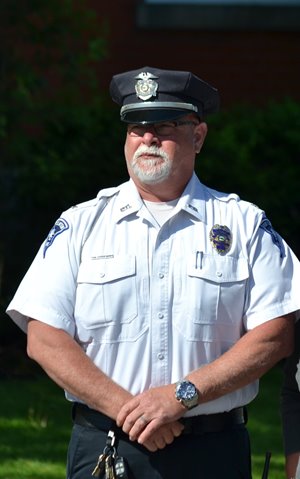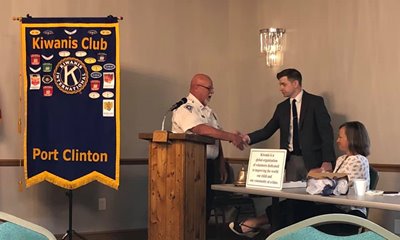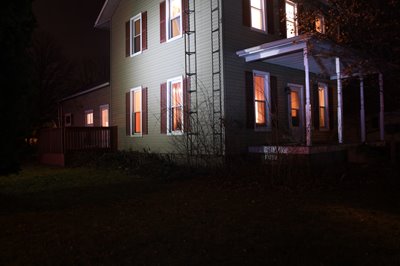 Harley Dilly
Harley Dilly
Port Clinton Police Chief Robert Hickman grew up two blocks from the home of Harley Dilly, the 14-year-old who went missing just before Christmas last year.
Young Robert attended church next door to where Harley would live with his family, across the street from the empty summer residence where the teenager would be found dead on Jan. 13, the result of trying to slide down the chimney to get inside.
In the 23 days preceding that grim discovery, Chief Hickman and his department faced social media-fueled protests and baseless accusations of ineptness, corruption and even complicity in Harley’s supposed murder.
The angry speculation came as the officers worked night and day, Christmas included; canceled holiday vacations; and along with the Attorney General’s Bureau of Criminal Investigation and partners from a dozen agencies:
- Searched more than 150 acres of land and water, both on foot and with the aid of drones and helicopters, dive teams and specially trained canines.
- Pored over weeks’ worth of surveillance video, futilely seeking a hint of Harley’s fate.
- Interviewed classmates and family members of Harley’s in Port Clinton as well as people from Washington state to Florida, a product of the teen’s active presence on social media.

None of those efforts turned up leads pointing to where Harley was — only where he was not.
Worse, all the law enforcement expertise Chief Hickman could muster wouldn’t be enough to save the boy’s life.
“That’s where I’m beating myself up, because we brought in other agencies that deal with this on a daily basis and they were just as stumped,” the chief said in an interview. “We had over 500 years of experience here every day, and we were all looking at each other saying, ‘What did we miss?’"
Seven months after the Harley Dilly case was closed, the chief still struggles with the outcome.
“Did we mess up, or did we not? I don’t know. I can’t give you that answer,” he said. “But my biggest recommendation for any department that experiences a case like this — don’t be afraid to ask for help.”
The truth, according to the autopsy, is that Harley had suffocated inside that narrow chimney before his parents even realized he was missing. There’s nothing the Port Clinton Police Department, or any other law enforcement agency, could have done to save him.
Yet that fact doesn’t bring peace to Chief Hickman, for whom the case was personal from the start. Hickman’s wife, Roseann, lost a child in a fire in 1988, and a decade later, the chief lost his only biological child in a stillbirth.
“I’d like to say it gets easier. It doesn’t,” he said. “But at least the family has closure, and that means more to me than anything. We don’t have that unanswered question, ‘Where’s my child?’”

Port Clinton Police Chief Robert Hickman
Immediate complications
By the time Marcus Dilly reported his son missing at 11:50 p.m. on Dec. 21, the teen hadn’t been heard from in 40 hours.
“We’re always working at a disadvantage in cases of missing children,” said a BCI agent who requested anonymity because she also works undercover. “The clock starts ticking before that Missing Child Alert or Amber Alert ever goes out, even when it’s immediate.”
Given Harley’s history of anger issues and problems at home, officers suspected that he had run away.
“Harley had stayed away before, spending the night with friends when he got upset. He’d come home when he calmed down,” Chief Hickman said about the teen, who had Asperger’s syndrome, attention deficit hyperactivity disorder and oppositional defiant disorder. “Most of our missing cases in Port Clinton, usually the kid’s gone for a night or a weekend because he’s mad at Mom and Dad.”
That’s more true than not statewide. In 2019 in Ohio, of the 24,292 people reported to the Missing Children Clearinghouse, less than a third of 1% had been abducted or kidnapped.
So Chief Hickman and Port Clinton officers began their investigation by interviewing Harley’s parents as well as friends he had stayed with previously. They gathered surveillance tape from a recovery home next to Harley’s house (the former church the chief attended) and nearby Magruder Hospital.
“We had to watch almost a week’s worth of video in real time,” the chief said. “I spent Christmas Eve and Christmas Day at Light House Sober Living, right next to the Dillys’ house, watching video. So did some of our officers, some of the drug task force. Everybody jumped in.”
But with the video providing no answers and Harley still missing on the holiday, Chief Hickman and his department turned to organizing a massive search, seeking community help, drones with infrared capabilities and specially trained dogs. The chief called in, among other agencies, BCI and the U.S. Marshals Service, State Highway Patrol, FBI, Ohio Department of Natural Resources and U.S. Customs and Border Protection.
Could Port Clinton have sought help sooner? Yes. It is impossible to ask for help too soon in such cases.
But BCI Special Agent-in-Charge Jimmy Ciotti, who helped work Harley’s case, doesn’t fault the chief for making time for those initial steps. Ciotti cited parsimony, the practice of starting an investigation by focusing on the most obvious angles.
“Hickman did a remarkable job from the start,” said Ciotti, who has worked in law enforcement for more than 30 years. “It’s just an unfortunate thing that the surveillance video didn’t reveal anything. Harley’s case was the aberration of my career.”
And the case was greatly complicated by the teen’s heavy use of Instagram, Facebook, YouTube and Reddit — like many other kids, Harley wanted to be famous. His online postings included videos in which he complained about his parents and others recorded while he was in the bathtub.
“He’s sitting there with no shirt on, just talking away in the bathtub,” Ciotti said. “He gave out his phone number and his address, and, basically, he did everything safety experts tell kids not to do.”
Many of the people Harley interacted with online, or who followed him or “liked” his posts, lived far from Port Clinton. And some, who had problematic histories, were people the teen would have refused to talk to in person.
The social media platforms were slow to respond to subpoenas, in part because of the holidays, which hindered the investigation.
In fact, because of vacations, some of the law enforcement agencies that partnered with Port Clinton initially sent teams with qualified investigators but not necessarily in the roles they were used to playing, Ciotti and others said.
Chief Hickman, whose department has 17 sworn officers, called those who hadn’t left the state back from holiday vacations. Port Clinton’s senior detective was in Florida with the city’s Boy Scouts troop, so Detective Ron Timmons, a Marine veteran who has been with the department since 2012, was assigned the case.
“Ron did phenomenal,” Chief Hickman said. “He’s a young detective, and I hope I’m alive to see him in my position someday.”

Chief Hickman names Detective Ron Timmons
Officer of the Year.
The wild world of social media
A YouTube search for “Harley Dilly” turns up dozens of videos in which people accuse his parents, Heather and Marcus Dilly, of killing their son.
BCI’s entire interview with Heather Dilly, obtained by a Toledo TV station via a public records request, was posted to YouTube, where dozens of people ripped into her in the comments section, accusing her of lying because she doesn’t say what they think she should say. Similarly vicious were the responses to the one interview she gave to a TV reporter.
Never mind that the investigation had included a thorough look at Heather and Marcus Dilly, their actions before and after Harley went missing, their home and the garbage truck that the father had driven on Dec. 20. The facts of the case eliminated both parents as suspects.
“I’m not going to judge the parents because I didn’t raise Harley,” Chief Hickman said. “They cooperated fully from Day One. Once we started talking to them, I was at their home every day. And if I’d asked, ‘Could I remove Harley’s bedroom wall?’ They would have said, ‘Yes, by all means.’ ”
But there’s an ardent segment of social media users who follow missing child cases as if they were a soap opera or a “choose your own adventure” story. The wannabe sleuths set up private groups in which they can, and do, run wild with speculation built from bits of evidence — sometimes true, sometimes untrue and sometimes wildly misinterpreted. They post theories and congratulate one another on connecting dots that police “failed” to.
“It’s unbelievable,” Chief Hickman said. “I never really looked at it that way until I started following other cases of people who went missing. Some of the same people commenting on Harley were on those pages. So I don’t know if they just sit at home and think up conspiracies — I don’t understand it.”
On YouTube, some theories centered on the fact that Harley’s coat was hanging on a bedroom door in the house where investigators found his body — evidence, the theories suggest, that the teen had been kept there by an abductor.

Harley's coat hangs on a door inside the home
where he was found.
They knew about the coat because a crowd of media and onlookers had gathered the night that BCI processed the scene, and some took photos through the lit-up windows.
“The mistake that’s going to haunt me for the rest of my life is we hung the coat up on the door,” Chief Hickman said. “We should have blocked the windows during the search — but that’s hindsight.”
The chief had been among the first officers to enter the home, he said, and he picked up the coat from the floor, turned it right-side-out and photographed it. He took the photo across the street to Harley’s parents to confirm that the coat belonged to the teen, an affirmation that supported the search warrant that allowed BCI investigators to comb through the house that night.
When the chief finished photographing the coat, he hung it on the door, in part because he hadn’t brought along an evidence-collection kit. He hadn’t entered the house expecting to find signs of Harley.
The conspiracy theorists didn’t care to learn the true context, though. They took the coat as “proof ” that police were hiding something.
“People took to wishing me dead, and people were giving me death threats,” Chief Hickman said. “I would tell my wife to stay off the rabbit hole (of the Facebook groups). I’d say, ‘Sweetheart, I’m used to it — you’re not.’
"Welcome to the world of being a police officer.”
At times, the online speculation and vehemence jumped from the virtual world to the real world, resulting in protesters demonstrating in Port Clinton before and after Harley’s body was found.
First, the protesters criticized the job Port Clinton police were doing, demanding, for example, that they bring in the National Center for Missing & Exploited Children or the FBI – both of which had already been on the case for weeks. The protesters also demanded that police charge the parents, who by that point had been cleared.
Later, protesters accused police of a cover-up.
After word got out that protesters planned to picket Harley’s funeral, the chief had to issue a strong warning that those without appropriate permits would be cited.
Also, Hickman’s department arrested protesters for trespassing on the property where Harley’s body was found and reported a Sandusky resident who had used Facebook to arrange a protest even though she was a Tier III sex offender barred from the social media platform.
“Be ready for protests, especially if a case like this is prolonged,” Chief Hickman advises colleagues. “Start thinking outside the box (to deal with protesters) because your community is always on your side, except for a handful of them. My neighbor still thinks I had something to do with it, which is crazy.”
The second-to-last puzzle piece
On Jan. 13, having exhausted leads in what increasingly looked like an unsolvable case, investigators decided to start back at the beginning.
“Lori Braunschweiger from BCI had recently gotten back from the holidays and became our new analyst,” Chief Hickman said. “We were driving from the landfill, where we were coordinating the search that would happen the next day, back to the PD, and I said, ‘Do you want to see where Harley lived?’”
She did, and when they were on Harley’s street, posed a fateful question: Had anybody checked out the summer house across from the Dillys’ home?

The home where Harley's body would be found
More than once, authorities had combed the double lot on which the house sits, sometimes using cadaver dogs and live-find dogs. They had found no signs of forced entry, and even a bloodhound so good that it had tracked Harley’s route to school six days after he had last walked it didn’t hit on anything around the house.
Given the ground they needed to cover, officers had moved on. The house sits among 180-plus buildings on the Dillys’ block and those immediately adjacent, and there are far more buildings between the high school and an expanse of empty land east of Harley’s neighborhood.
Port Clinton, which has about 6,000 year-round residents, sees many homes occupied only during the summer, when the city’s population quadruples. What some civilians — including the backseat Sherlocks on social media — misunderstand is that entering an empty property requires proof that there’s a reason to, usually via a search warrant, or permission from the owner.
“But since we’re starting back at square one,” Chief Hickman told Braunschweiger, “let’s check it again.”
When the two got out of the cruiser to walk through the yard, Hickman discovered an empty lockbox on the backdoor that had previously gone unnoticed. Over the next several hours, the chief ’s wife, a real estate agent, would help identify the elderly owners as residents of Avon; a Port Clinton officer would make the hourlong drive there to pick up a key; and the chief and police officers would enter the home for the first time.
That’s how they came to find Harley’s coat and sweatshirt on the second floor.
An ‘almost unbelievable’ answer
Beyond the clothing, specialized BCI crime-scene investigators who searched the house that night found no other obvious evidence of Harley: no footprints in the construction dust, no food wrappers, no scent of decomposition.
The water in the home had been shut off; only the first floor was heated, a bare minimum at that; and the second-floor staircase had been blocked with a large piece of paneling.
The chimney flue, often described as blocked between the first and second floors, actually didn’t extend to the first floor. The home had no fireplaces, and plaster walls on the second floor encased the chimney.
The only suggestion that the chimney was there was a pair of 6-inch-diameter holes, one each in the rooms flanking the chimney — flue vents whose covers were found on the floor.
Those elements were like puzzle pieces that refused to come together to form a single picture.
BCI Special Agents Dave Hammond and Megan Roberts had seemingly hit a dead end, but they refused to leave until they solved the mystery of how Harley’s clothes had come to be in the house.
“If it hadn’t been for their outstanding work, I don’t believe Harley’s body would have even been found,” said the BCI agent who requested anonymity. “Those agents racked their brains over the evidence presented before them, which was sincerely odd.”
The flue vents turned out to be the key. After a camera sent into the chimney returned nothing useful, the agents reached into the holes.
“Hammond called me over and said, ‘I think I felt a boy’s head or a large animal that’s dead,’” Chief Hickman said. “So he goes, ‘I don’t want anyone in here because we’re going to surgically remove the chimney.’”
That’s how the agents found Harley, a mini-flashlight at his feet.
“Harley’s outcome – it is tragic and almost unbelievable,” the anonymous BCI agent said. “I know when I first heard, I had more questions just based on its absurdness.”
The strangeness fed the online speculation, but people have died in chimneys:
- In 1977, 14-year-old Robert Thompson went missing in Los Angeles. Twenty-eight years later, his body was found in a chimney at a house just blocks from where he had lived.
- In 2001, the remains of 27-year-old Calvin Wilson were found in a chimney in Natchez, Mississippi. The man had gone missing 15 years earlier.
- In 2008, 18-year-old Josh Maddux was found in Colorado Springs inside a chimney in a cabin a mile from his parents’ home. He had gone missing seven years earlier.
“To be honest with you, had Harley not kicked his jacket out of that chimney flue, we would have never known he was there,” Ciotti said.
Years might have passed before his body was discovered, as happened in the three earlier cases.
“Because those crime scene agents are smart individuals who care about people and don’t give up, they found him,” the anonymous BCI agent said. “I was never prouder of BCI than when I heard.”
Harley had apparently climbed a rigid metal TV-antenna tower outside the home and clambered into the chimney’s only opening — on the roof. He likely intended to explore the home or find a hiding place while he skipped school.
An autopsy determined that Harley died within a few hours of going down the chimney, the result of compressive asphyxia inside the 9-by- 13-inch flue. The teen had no other injuries and had apparently shimmied out of his clothes while inside in an effort to get more room to breathe.
“My heart still mourns for Marcus and Heather,” Chief Hickman said. “No child should have to die like that so close to your house.”
Officers who care
The discovery of Harley’s body finally brought clarity to the case.
“Harley had such a large social media presence, and he just went radio silent that Friday,” Chief Hickman said. “This made perfect sense when nothing else up to this point had.”
Having an answer, however, didn’t ease the disappointment for the officers and agents who had been searching for the teen or for the community that cared about him — all of whom had endured 23 days of hell.
BCI investigators and the Port Clinton police held a debriefing so that agents and officers could share their interpretations of the case, learn from the experience and, hopefully, move on.
“In today’s day and age, you need closure — you need to get everything out,” Chief Hickman said. “We needed that, whether everyone believed it or not.
“Actually, I had a couple of officers come up and thank me for doing that because we did everything we could and it just stinks that Harley was 100 feet from his house. But there were no signs of it.”
Five weeks after Harley’s body was found, Chief Hickman wrote a letter to the residents of Port Clinton.
“Words cannot express the gratitude we have for the care and concern that was received from this wonderful community,” he wrote.
Because even as the online trolls howled, members of the community cooked meals for the officers, sent them cards expressing their appreciation, and put up pink lights and ribbons to support the search for Harley.
That is the Port Clinton that Chief Hickman knows as home, and the reason he sticks with a job that can seem crazy and undervalued day after day.
Amid the turmoil and protests that have roiled the country this summer, too many have overlooked law enforcement’s good intentions.
“Cases like Harley Dilly’s are solved because of the passion and determination of the officers and agents who work them,” Attorney General Dave Yost said. “Make no mistake — they are solved because law enforcement cares.”
Advice for tough cases
For departments facing a complicated case not unlike the one involving Harley Dilly, Port Clinton Chief Robert Hickman and BCI agents offer this advice:
- Get all the resources you can as soon as you can. Other agencies want to help. “All the agencies that were here were phenomenal,” Chief Hickman said. “There were no egos, and that was really pleasant to see.” The extra manpower also helped the Port Clinton officers cover both the usual daily business and the special investigation, and built connections among officers and agents who work throughout the state.
- Record and preserve everything. Take extensive notes about what has been checked, including buildings and people, to help coordinate with other agencies that join the investigation.
- Immediately get all the camera and surveillance footage possible. You have only a 24-hour window to secure video footage that records over itself once a day. You don’t have to review everything right away, but it might help later.
- Take care of your people, as they’re your best assets. For example, when Chief Hickman’s wife, Roseann, noticed that officers weren’t getting any sleep, she reached out to their family members to ask what they needed. “It was truly a family effort,” the chief said.
- Be aware that the public is watching everything you do. But also remember: Your community has your back, even if they’re not as loud as your critics.
- Remember that hindsight is always better than what you know at any time.